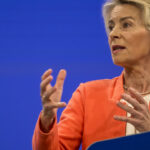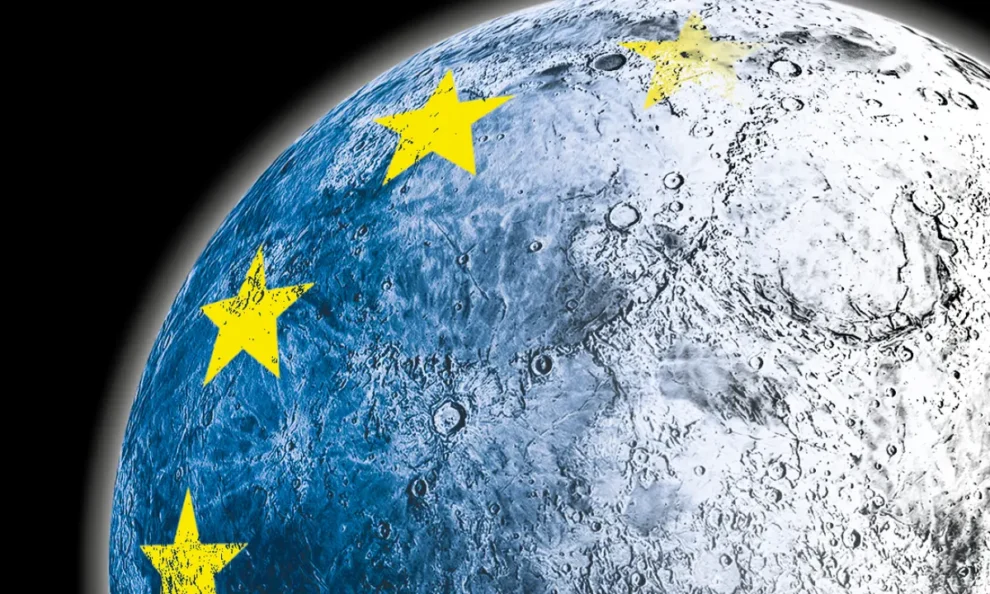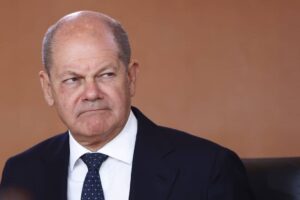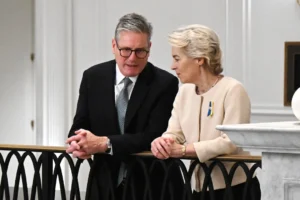The European Space Agency’s plan to build a cargo vessel that can convert to a crew ship is one giant step in its ambitions to compete with rival lunar exploration programmes
As space exploration announcements go, a recent speech at a European Space Agency (Esa) summit could hardly rival President John F Kennedy’s oration at Rice University in Houston, Texas, in 1962, when he emphatically announced: “We choose to go to the moon.” Those words set the US on the path to landing Neil Armstrong and Buzz Aldrin on the surface of the moon on 20 July 1969, effectively ending the space race with the Soviet Union.
However, when Esa’s director general, Josef Aschbacher, spoke to the press in November, after the Esa space summit in Seville, Spain, what his speech lacked in hyperbole was made up for by its importance to Europe’s space programme.
By the unanimous agreement of the 22 European countries that fund and govern Esa, which include the UK, the space agency would open a competition for industry to propose a cargo spacecraft to fly to and from the International Space Station (ISS) by 2028. But the gamechanger came in what Aschbacher said next: “We will also conceive it in a way that it is not a dead end, meaning that it’s open and can evolve in the future to become a crew vehicle if member states decide to do so.”
This would be the first time that Europe has developed a crew transportation vehicle, and while it would initially be used to transport humans to and from the ISS, Aschbacher also told the gathered press that a further evolution of the design – again, pending Esa member states’ agreement – could serve other destinations beyond low Earth orbit. And there is the potential for history to be made, because if political will holds strong, Europe has begun the journey that could result in it developing the capability to land its own astronauts on the surface of the moon.
Not that Esa necessarily wants to go it alone. Frank De Winne is head of Esa’s European Astronaut Centre in Cologne, Germany. He sees developing these capabilities as the route to stronger partnerships with the US and other countries.
“Being a strong partner with similar capabilities makes you a better partner,” he says, pointing out that when the US space shuttle programme was retired, Russian Soyuz capsules kept the ISS operational by boosting its orbit (so it wouldn’t fall back to Earth) and taxiing crew up and down from Earth.
The Ukraine war, however, has essentially severed ties between Russia and Europe and the US for future projects, opening a clear opportunity for Europe to fill this void. Only three countries in the world possess the independent capability to launch their own astronauts: the US, Russia and China. India is making no secret of its ambition to become the fourth with uncrewed test flights of its Gaganyaan capsule, scheduled to begin next year.
The impetus for Esa to urgently chart its own direction towards a human transportation system came in February, when the agency published a report called Revolution Space: Europe’s Mission for Space Exploration. Authored by a 12-strong team of independent advisers, the document argues that space is undergoing a revolution comparable with the growth of the internet 20 years ago, and that, like the internet, this will affect all domains of life. In many ways, it already has.
Our society is now utterly dependent on the satellites that orbit Earth. The communications and navigation services that they make possible are so interwoven in our everyday lives that in the UK, space is classed as one of 13 critical national infrastructure sectors.
The Revolution Space report concludes that a strong, independent means of launching payloads and even people is critical to Europe’s future prosperity. Without it, the report says, Europe will be placed in the role of customer to the other space-faring nations, in the same way that the world now largely relies on Silicon Valley for computing.
This was reflected in the way Aschbacher wants Esa to develop the cargo vehicle, and a new rocket, also announced in Seville. Instead of Esa working with a contractor to design and build the spacecraft, the space agency will buy the service from a company. Esa will not own the resulting vehicle, the company will, and the business can sell those services around the world to whoever is willing to pay for them.
This is the model that Nasa has pioneered with Elon Musk’s SpaceX astronautics company in the US for launch vehicles, which has achieved spectacular results. “There’s no doubt SpaceX has reduced the cost of getting things into space in general, and the moon will clearly be a beneficiary of that, commercial actors are enabling a faster pace of lunar exploration,” says Prof Ian Crawford of Birkbeck, University of London.
Indeed they are; Nasa is already deploying the same service procurement model with private American companies to develop expertise in landing robotic payloads on the moon. If all goes to schedule, on Christmas Eve, US company Astrobotic Technology will launch Peregrine Mission One, a lunar lander that the company has designed and built through Nasa’s commercial lunar payload services programme.
Interest in going to the moon is exploding around the world. Dr Nasr Al-Sahhaf experiences this on an almost daily basis. He chairs International Moon Day, which is observed every 20 July, after being sanctioned by the UN general assembly in December 2021. Sahhaf’s job is to interface with companies and governments across the world that have an interest in celebrating the future of lunar exploration.
“I found that there is not only global interest in humanity’s going back to the moon, but also there is this clear zest to explore and settle the moon as if to make up for such a long absence since the Apollo missions,” says Sahhaf.
And that interest is also coming from many new players. Of the three dedicated robotic missions to the moon that launched this year, only one came from a traditional space power and, pointedly, failed. On 19 August, Russia lost control of its lunar lander while attempting the descent and so Luna-25 crashed into the barren surface.
In July, India had launched the Chandrayaan-3 spacecraft. It entered lunar orbit on 5 August, and then its lander successfully touched down near the lunar south pole on 23 August. This feat made India the fourth country, after the US, Russia and China, to soft-land on the moon, and the first to land at its south pole. The latter is the focus of attention for future lunar bases because of the presence of water ice in the permanently shadowed lunar craters there.
The third mission, Japan’s Smart Lander for Investigating Moon (Slim), launched on 6 September from the country’s Tanegashima Space Centre Nicknamed the “Moon Sniper”, the craft is now orbiting the moon and is expected to attempt a precise landing on the surface in January.
I think it is essential that when humanity decides to go to Mars that Europe is part of that and we have a seat at the table
Frank De Winne, European Space Agency
Precision in this case means landing within just 100 metres (328ft) of a predetermined point. Such a technique will be crucial for delivering people and equipment to a designated landing pad on a future lunar base. For comparison, when Apollo 11 carried Armstrong and Aldrin to the lunar surface in 1969, their landing zone was anywhere within a landing ellipse – the region within which a probe is expected to land based on its approach trajectory – of about 11 miles by three miles (approximately 18km by 5km) in size.
The downside of this global interest, Crawford worries, is that it could result in some kind of new space race and lunar landgrab unless some form of coordination and eventually governance is agreed upon for activities on the lunar surface. Yet there is a marked lack of legally enforceable agreements.
The closest the UN got was the moon treaty of 1979, which tried to enshrine the idea that the moon and its resources were a common human heritage and that their exploitation was therefore forbidden except through some internationally agreed framework, which was never forthcoming. The treaty itself was signed by only a handful of countries, and not by the big space-faring ones such as US, Russia and China. In the eyes of many, therefore, it has no teeth in international law.
However, in 2007, 14 of the world’s space agencies set up the International Space Exploration Coordination Group (ISECG) to allow them to exchange plans and coordinate their efforts. “ISECG deserves much more attention than it normally ever gets in these discussions,” says Crawford.
That’s because it includes China, Russia, the US, Europe and Japan, among others, and despite all the upheavals on the world stage since its inception, the ISECG has remained strong and focused. Its next meeting will take place in December. Working together, the agencies involved have produced the Global Exploration Roadmap, which presents a vision for what different space agencies around the world could contribute voluntarily to a global lunar exploration effort.
“This provides a framework,” says Crawford. “Currently, it doesn’t have a lot of high-level political visibility, but the point is the framework does exist, and I think it deserves to be strengthened.”
Beyond ISECG, there is also the Moon Village Association (MVA). Founded in 2017, this not-for-profit organisation was established by Giuseppe Reibaldi after a 35-year career at Esa. For nearly half that time, he worked to develop payloads for the European Columbus laboratory module that is part of the ISS.
“I came to realise that civil society should have a role in the exploration of the moon, and that the creation of an NGO [non-governmental organisation] focused on the moon will help to catalyse all kinds of stakeholders, from different countries, industry, academia, as well as economic and cultural disciplines,” says Reibaldi.
The MVA will hold its seventh global workshop in Kurashiki and Tottori, Japan, in December to discuss best practices in lunar exploration. It also initiated International Moon Day and has permanent observer status at the UN’s committee on the peaceful uses of outer space.
Ultimately, whatever international organisation evolves to govern lunar activities, whoever gets there in the first tranche of countries will inevitably be the ones with the greatest say in outer space activities. And that means there is more on the table than just the moon. Many see the moon as a proving ground for the big prize: Mars.
“I think it is essential for Europe that when humanity decides to go to Mars that Europe is part of that and we have a seat at the table,” says De Winne. “That will only happen if in Europe we have the necessary capabilities.”
De Winne and colleagues will now study how the Revolution Space document’s recommendations can be further implemented, reporting their findings to the next Esa space summit in 2025 to await what decisions will be made.
Source: The Guardian










































